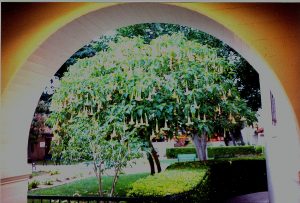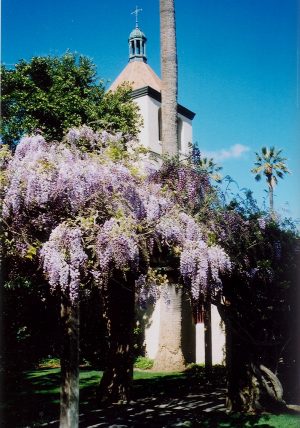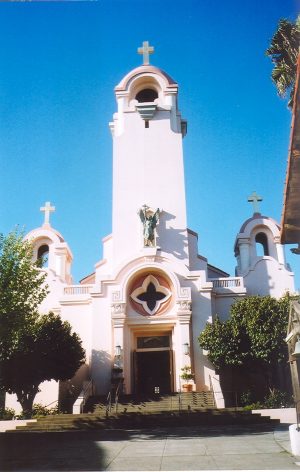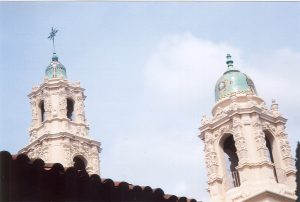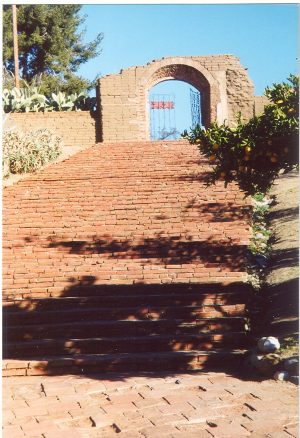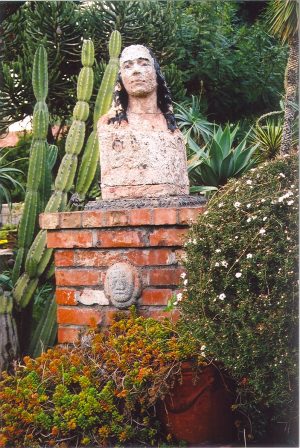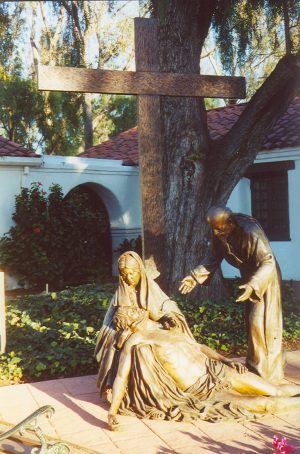15) SAN JUAN CAPISTRANO. What can you say about Capistrano? Lots of things, not all of them good. It’s the only mission we’ve been to that has TWO shrines. One is called Serra’s Church, and is really an oversized chapel that was built when the Great Stone Church came crashing down. The other is to Rene Leon. Rene … who? Why, the dude who wrote that silly little song about the swallows. You know, the swallows that return on the same day every year … only now there’s just a handful of them, but every TV station in the Southland feels it must send the dumbest cub reporter on the staff down there as punishment. (You want swallows? I’ll give you swallows. Go to Sauvie Island north of Portland in the spring. I don’t know what the arrival date is, but I know that one day there’s no swallows, and the next day they are all over the place. They build their nests under the eaves of all the buildings, and if you stand too close they will make a strafing run at you, and at cats, too. And you can watch Mommy or Daddy Swallow swoop up to the nest and hover, while three or four little heads pop up. The chicks’ mouths are actually larger than their heads. I don’t know how they do that, but they do.)
The shrine to Rene Leon contains his desk and his piano and lots of memorabilia, and it is certainly appropriate to have it there, because without it Capistrano would be just another mission … no, it would be less than most of them, because it has no big original church. With the song (which I don’t think I’ve ever heard except when Bugs Bunny would sing it in the bathtub—which was actually a kettle Elmer Fudd was using to make a wabbit stew) … with the song, Capistrano is a genuine tourist attraction. Everything in the neighborhood is named Mission This or Swallow That. It’s hard to find a place to park. There was an actual line to get in, and the price was $6, by far the most we’ve paid. (The next one, Buenaventura, charged only $1, most of the others are $2 or $3.) They publish their own newspaper. Just bi-monthly, but still …
There were probably more people there than we’ve seen in all the other missions we’ve visited put together. There have been times when we were the only visitors to a mission. Capistrano is definitely not my type of mission experience …
… And yet, I’ll admit there’s a lot to see. Nothing you couldn’t see with less crowding at other missions, but if you planned to see just one, this would be a good one.
Unique to Capistrano is the ruins of the church. It was made from stone, the only one of the missions like that, and was reportedly the wonder of California until a big quake brought down all but the back wall and portions of the sides. It was never replaced. Instead, a smaller hall was built, Serra’s Church, which is the oldest building in California, and furnished with a glorious golden altar from Spain. The ruins of the old church are now covered with scaffolds as engineers try to preserve them, since another big shake could bring down even the little bit that’s left. I don’t think there are any plans to rebuild it, just preserve the remainder. And of course, since it’s Capistrano, American Express just donated $150,000 to the project. If they gave it to a mission that really needs it, like Soledad, nobody would ever hear about it.
16) SAN BUENAVENTURA. Located in the town that used to be called Buenaventura but now goes by simply Ventura. On our first attempt to visit we got there at 9 AM, and found the museum and grounds didn’t open until 10. We had already had breakfast and didn’t fancy waiting around, so we headed off east through country I’d never seen before: Highway 126 north of the Simi Valley, through Santa Paula, Fillmore, and Valencia, to Mission San Fernando.
On the way back home, due to horrific traffic through LA, we almost missed seeing this one again, this time by being too late. We got there at four-fifteen. But I had noticed the mission and grounds seemed quite small, so we paid our $2 and went into the one-room museum. The only thing of note was a very old wooden bell. The bells of Buenaventura were made of wood, it seems, the only mission that had them. Not exactly something to brag about, I figure, and there wasn’t much else. Like San Luis Obispo, this one has been crowded out by the town. The gift shop isn’t even part of the mission, as it has been in all the others; it was in a storefront on main street.
The grounds consist of a small garden and the church itself. In the garden was a tree that we were told was an “Angels Trumpet.” I’ve seen plenty of flowers shaped like trumpets, but these were as big as actual trumpets. No kidding! They hung all over the tree, bell down. A hummingbird could have flown in and rattled around for days before finding his way out.
In the church there was an Hispanic family waiting their turns at the confessionals, both of which had lights indicating there was a bi-lingual padre inside ready to listen. I’ve always wanted to hang a sign outside one of these: EXPRESS BOOTH, 10 SINS OR LESS. (I stole this idea from John Callahan, the quadriplegic cartoonist.)
It occurred to us that we’d seen a wedding, a funeral, and confession in missions thus far. I wondered what our chances were of seeing all seven sacraments. (Once I start collecting things, be it books or missions or sacraments, I’m never content until I have the whole set.) Back home I learned something that I’d actually known already but forgotten: a funeral is not a sacrament. So what was left? Communion would be easy, just attend a mass, which is celebrated regularly in almost all the missions. I thought there was a fair chance of catching a baptism. As for the others … Anointing the Sick (formerly known as Last Rites, or Extreme Unction) … possibly I could fake a heart attack during a combined Confirmation/Ordination service …? Naaaah.
17) MISSION SANTA CLARA DE ASIS. This gets confusing. Mission Santa Clara is in San Jose, and Mission San Jose is in Fremont. I’m not sure why. We went to this one on our way back from trip to the Santa Cruz area, jogging north to San Jose to see it and the Winchester Mystery House. The mission is on the grounds of Santa Clara College and you can’t drive to it because of campus parking restrictions, and can’t see it from any road you can drive on without a parking sticker, so it was a little tough to locate. Finally we parked and walked onto the campus and asked a student. Turns out it was only a block away.
It’s a lovely mission … with about as little authentic about it as any in the chain. The current building is no less than the sixth to carry the title, and it’s not even in the original location. The story behind that is long and complicated and we wouldn’t even have known it if not for Huell Howser, the California Tour Guide on PBS. There is much to admire here, but not much that really set it apart, gave it its own character, aside from the unusual location, except for the largest, finest wisteria arbor I have ever seen. It was in prime blossom, absolutely delirious with purple flowers, and when we walked under it the gentle breeze that day showered us with petals.
One annoyance … this is the only mission of the 21 that has no gift shop, probably because of the campus location. We have been collecting cheap refrigerator magnets as souvenirs of our travels, and have been diligent about getting one from each mission. Not Santa Clara, though. We visited the college bookstore, no dice there, either. Mostly we buy little tiles, two inches square, with paintings of the missions on them, and we’ve paid from $2 to $5 for them, but more expensive ones are available, a set of tiny ceramic models of the buildings that are very nice, at $10 a pop. Do the math, that’s $210 if we got one at each mission, plus tax, a little steep for us. But if we simply cannot find the tiles, we have bought a few of the $10 ones. We had to pick up a $10 Santa Clara magnet at the next mission down the road.
18) MISSION SAN JOSE. Located right on the main highway through the old part of Fremont, in the East Bay. We hit this one the morning before my book signing in Berkeley. It is another reconstruction, but an exceptionally good one. At some point near the turn of the century the original mission was torn down and replaced by a New England Presbyterian-type church, complete with steeple. Much later that church was moved to a new location, and good riddance, I say. There is a good exhibit in the museum, showing the pains they took in reconstructing the old mission exactly as it had been before the traditionalist minister ruined it. They did a great job. Beside the building was a very good graveyard; Lee was in heaven, taking pictures of most of the tombstones.
19) MISSION SAN FRANCISCO DE SOLANO. The mission is in a state park in Santa Rosa that also includes the barracks used by the early garrison of the town. Across from that is the town square with an old Carnegie Library converted to the town museum and visitors bureau. There is also a monument commemorating the establishment of the Bear Flag Republic, which seems to have lasted about 16 days or so before the revolutionaries handed everything over to the Americans, including Spanish land grants stretching back many generation. The whole thing sounds fishy to me, like it was a setup to get all those greasers off all that valuable property and turn it over to white people. Which is exactly what happened.
Santa Rosa is a beautiful old town, largely untouched by “progress.” Most of the buildings are old, and they’ve been renovated, but in a way to retain their charm. The mission itself was the very last and northernmost of the entire chain. It started out as the “assistencia,” sort of an auxiliary to the San Francisco mission, and was only in operation for a few years. When it fell into disrepair like so many of them did, it fell all the way, so that when interest in the old missions grew last century there was almost nothing left of it. Not even many pictures, to the point there was no very clear idea what it had looked like. The state erected a new building “in the spirit of the missions,” incorporating many ideas from other missions, but they admit it could have been much different. Now even that is getting a bit old. The best thing in the museum is a large collection of paintings done by an artist in the early 1900s, of the missions as they existed then … but half of them have been removed for safekeeping, those that used to hang on the southern wall, because the ceiling on that side leaks …
20) MISSION SAN RAFAEL ARCANGEL. This is another reconstruction, and is really just a chapel. It is just north of downtown San Rafael, two blocks from the street George Lucas used for all the cruising cars in American Graffiti. It sits off to the side of a much larger church, which was not open when we visited. One of the less interesting, all in all.
21) MISSION SAN FRANCISCO DE ASIS. A good place to end our explorations. It is also known as Mission Delores, because of its location on Delores Street. I lived in San Francisco for about five years and must have driven by this place a hundred times and never even glanced at it. It is easy to miss unless you’re looking for it, because it sits beside a newer church so big I’d almost call it a cathedral. But if you stand across the street and look at them side by side, it is the mission that catches my eye with its simple but powerful lines, and its columns. There have been several churches on the corner, but only one mission, which survived the quakes of 1812 and 1906 with very little damage while its gaudier neighbors were destroyed. It came through the World Series quake, too. That thought made me happy, for some reason, that humble little building with walls of adobe six feet thick, erected by Indians and designed by amateur architects.
The big church is odd from the outside, with two huge towers that, for some reason, are seriously mismatched, looking not at all like each other. Possibly one shook down in a quake, but then why not replicate it when rebuilding? I never found out the reason, but it is quite a lopsided structure, and not in a way that pleased me. Inside was another story. It is a vast, vaulting interior with huge and beautiful stained glass high up, and it was draped in great swooping swathes of purple fabric for Lent. The prize, however, was a series of smaller stained glass windows down at the people level, depicting all the California Missions, and Junipero Serra, whose statues we had become very familiar with, as each mission seems to have one. Lee took a picture of each window, but we haven’t developed them yet. I’m keeping my fingers crossed.
Mission San Francisco was among the better-patronized ones, there were a fair number of people when we were there. Like Capistrano, it has a claim to fame that came long after it was built. With Capistrano it is that silly little song. With Mission Delores it was Alfred Hitchcock, who filmed Kim Novak wandering the graveyard and Jimmy Stewart following her in “Vertigo.” (Did you know there are only two graveyards in the entire city of SF? There’s this one, and the military cemetery in the old Presidio. Frisco has always buried its dead in the town of Colma, some miles to the south, with a population of 100s of thousands of stiffs and about 40 living people.)
NUESTRA SENORA DE LOS BANOS SANITARIOS. Probably the most obscure of all the missions, but we swore to visit them all … Toward the end of his life, Father Junipero Serra became victim to many of the infirmities of old age, among them an irregular bowel and prostate troubles. The missions were planned to be separated by one day’s ride on horseback, but the Father could no longer make it that far without answering a call of nature. So these intermediate missions were established halfway between the regular missions. There were several, of which only one survives. The site is not well advertised; in fact, you have to know someone, but we’ve made contacts in our travels and were able to locate it. We’re pledged not to reveal its location. It’s quite a small adobe structure, “Our Lady of the Clean Restrooms,” just two rooms side by side, so it can also be used as a confessional. The door has a crescent moon on it, symbolizing God’s Grace in Indian myth, and inside ancient copies of “El Catalogo de Sears y Roebuck” are nailed to the wall and, of course, there is the throne with a hole it in … a thoroughly unpleasant place, even after all these years. Avoid it on your mission tour.
So now we have 21 mission refrigerator magnets clinging to the exhaust hood over the stove, since the door of the fridge in the RV seems to be made of plastic.
May 1, 2004
Oceano, California

